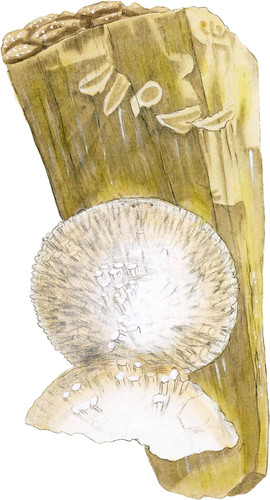 Enlarge
Enlarge
British Mineralogy
Globular Carbonate of Barytes
- Class 2. Earths.
- Order 1. Homogeneous.
- Gen. 6. Barytes.
- Spec. 2. Carbonate.
- Div. 2. Imitative.
Sulphate of barytes has been represented in tab. 96 of a globular form, and I believe it was thought almost a distinguishing character of the substance. Since Carbonate of Barytes has occurred in globular forms also, it becomes necessary to show the distinction, as we do not know that it has been before observed by any author. According to a specimen I have received from Dufton in Westmorland, which is rather a wedge-shaped fragment—see the back figure—they may be tolerably large, as this fragment, which seems to have been part of a ball, being near six inches long, promises some of a larger formation, and I have seen some balls pretty perfect, from one to three or four inches in diameter. An opaque roughness generally occurs on these nodules, which sometimes show a tendency to crystallize in six-sided prisms, either with or without six-sided pyramids*, or only with part of a six-sided pyramid, the end being truncated—see the top large specimen and part of the smaller. I do not show the most distinct, as in those, they are easily distinguished. The fractured parts have something of a columnar radiation; but very indistinctly and massively incorporated, and the fracture is otherwise small or largish, irregularly splintery, without any sign of internal crystallizational fracture. This is so peculiar to Carbonate of Barytes, that it was chiefly known from other substances by this mark, before it was found formed in external crystals, although that had not been particularly described. I have a large piece of radiating Carbonate of Lime from my kind friend F. Hall, Esq., of Arkendale, fourteen inches long, on the face of which the appearance so far corresponds with Carbonate of Barytes, that many good mineralogists have doubted which it really is; but the fracture of Carbonate of Lime soon exposes it. Carbonate of Barytes, or Witherite, may thus be in part known by its fracture. I have had dark specimens with Pyrites in it so coloured by the Iron, that, for want of the above observation, they would not have been known from Carbonate of Lime.
- * Such as tab. 109, being, however, very rare.

